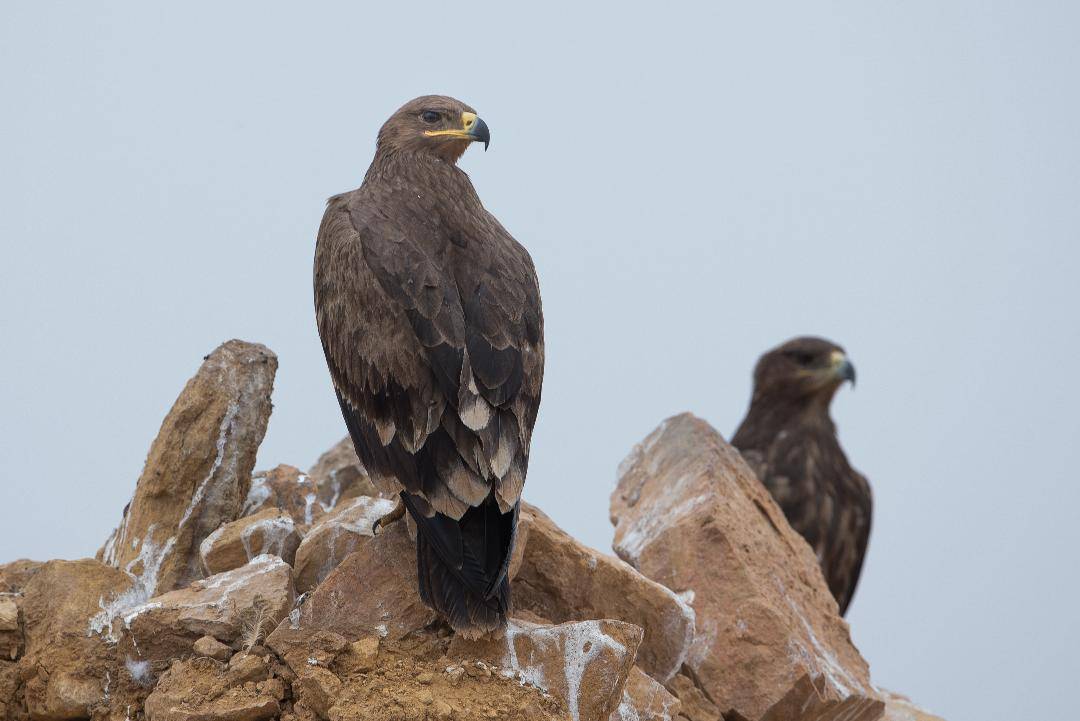Globally important numbers of Steppe Eagle discovered in Saudi Arabia: an update

A guest blog by Jem Babbington, Phil Roberts & Mike McGrady
Further monitoring has been undertaken following on from the initial counts of approximately 4900 Steppe Eagles recorded at two rubbish dump sites north of Riyadh. See here for details of the initial sightings: https://osme.org/2019/11/globally-important-number-of-steppe-eagles-discovered-in-saudi-arabia/
Additional counts by Jem Babbington and Phil Roberts have estimated that the number of Eagles using the sites is even greater. Systematic counts at the two sites; 9 km south-west of Shaqra (25.162018°N, 45.195724°E) and 6.5 km south-west from Ushaiqer (25.303000°N, 45.125000°E) estimated a total of 6700 Steppe Eagles. In addition, 19 Eastern Imperial Eagles, five Greater Spotted Eagles, four Black Kites and a Eurasian Griffon Vulture were also recorded.
These observations of a single assembly of approximately 6700 endangered Steppe Eagles at two rubbish dumps in central Saudi Arabia are truly astounding, especially when one realizes that could equate to about 10% of the estimated world population. Once one gets over the initial shock of such an aggregation, the vulnerability of the birds at those sites to threats like poisoning and electrocution comes into focus, and one realizes just how much impact a single poisoning event or a few dangerous electricity poles in the vicinity might have on the global population. That realization is further magnified by the fact that there are thousands of dumpsites (large and small) being used by Steppe Eagles during passage and wintering. Indeed, the tracking data that led to the Saudi Arabia site shows eagles visiting dumpsites in Oman, Yemen, Iraq, Iran and elsewhere and highlights the potential risk eagles face across their global range. Because of this, it is important that close consideration is given to anthropogenic waste management decisions, and the effect they might have on scavenging birds. While ever more human refuse is an environmental crisis, the good news is that modern waste management need not be entirely detrimental to scavenging birds, and could provide abundant, safe food, and other benefits.
Useful reading
BirdLife International 2014(?) Waste management best practices to conserve migrating soaring birds (MSBs) in the Rift Valley-Red Sea Flyway. http://migratorysoaringbirds.undp.birdlife.org/sites/default/files/waste_management_best_practices.pdf
Margalida, A., Donazar, J.A., Carrete, M. and Sánchez‐Zapata, J.A., 2010. Sanitary versus environmental policies: fitting together two pieces of the puzzle of European vulture conservation. Journal of Applied Ecology, 47(4), pp.931-935. https://besjournals.onlinelibrary.wiley.com/doi/full/10.1111/j.1365-2664.2010.01835.x
McGrady, M., Al Amri, T. & Spalton, A. 2019. Protecting nature’s waste managers. https://www.natureasia.com/en/nmiddleeast/article/10.1038/nmiddleeast.2019.80
